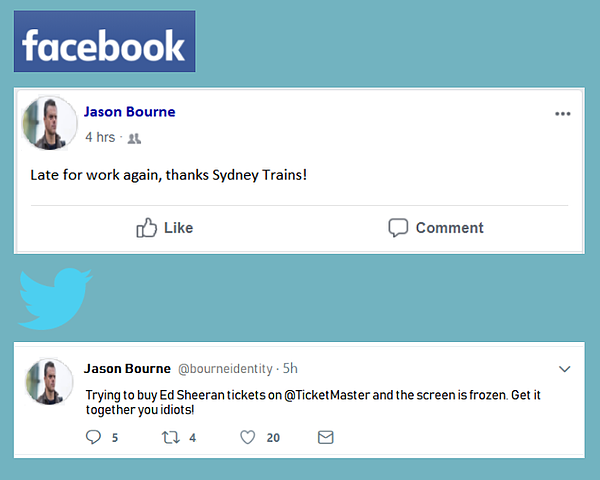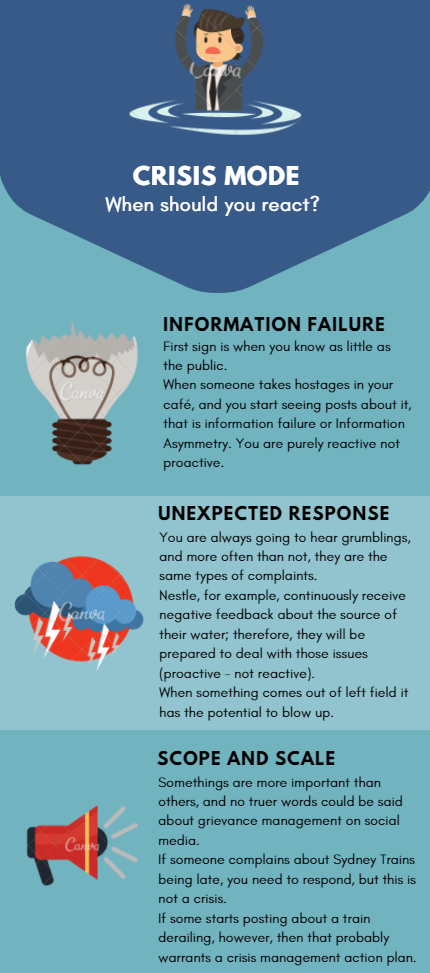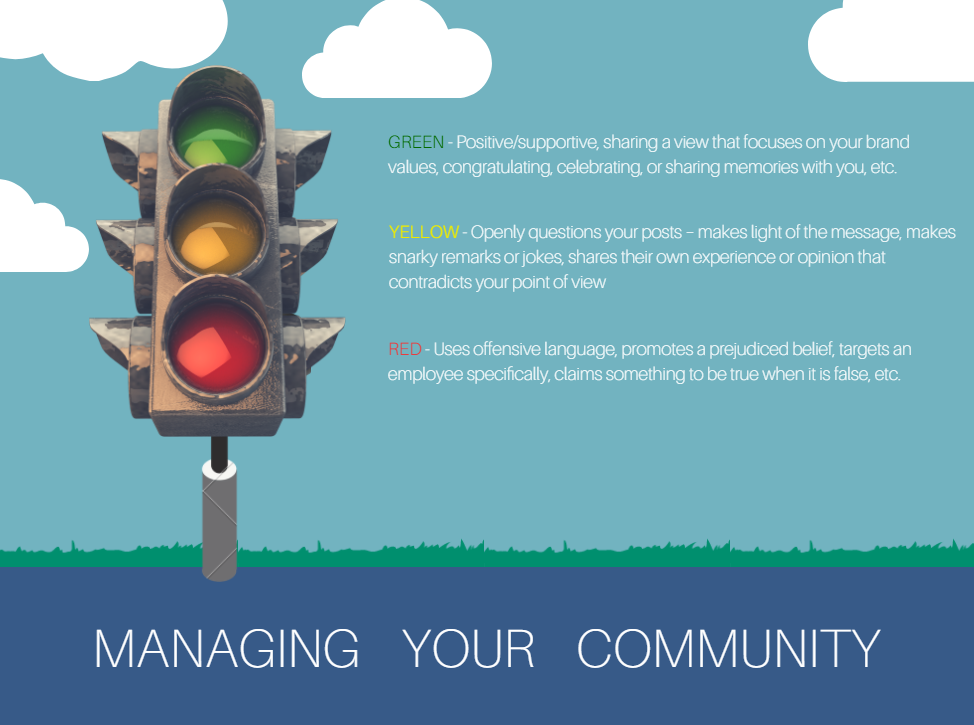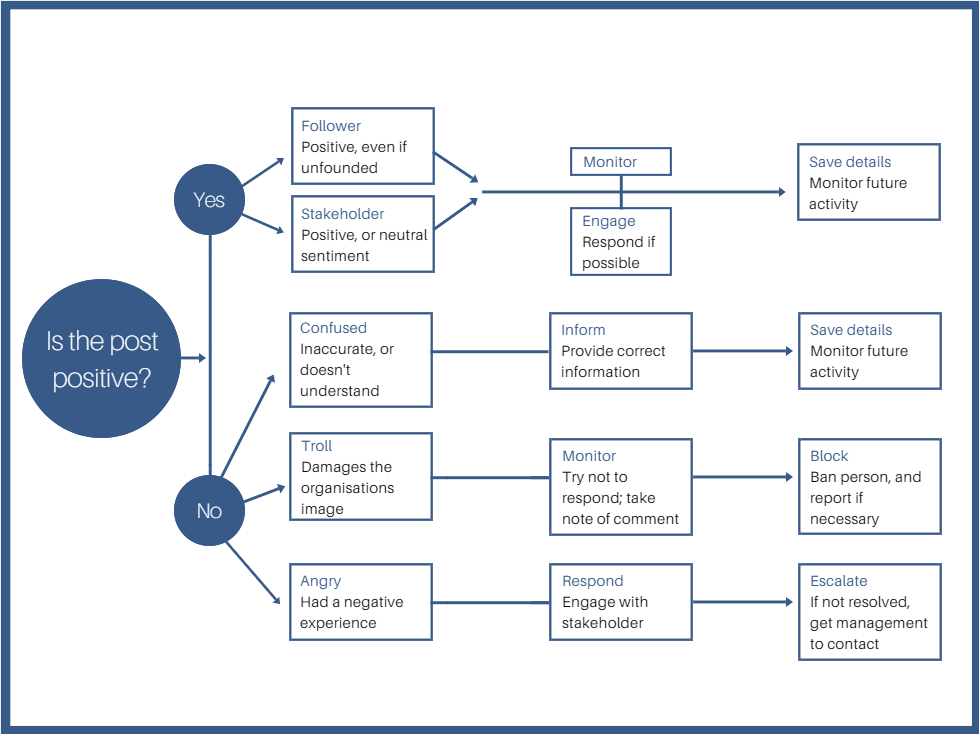

Social Media Crisis Management


Community engagement always has the potential to spark controversy and require crisis management. Sometimes that can occur despite the best of intentions and engagement approaches.
If crisis management comes to play, do not despair or feel like your engagement activities have been a wasted effort. You put your project and your organisation out there enough; you’re bound to come across someone with a pitchfork and torch…
Social Media is kindling for negativity, and like a bush fire, an adverse opinion can consume your pool of stakeholders.
So, when commencing with stakeholder engagement via social media, what do you do when presented with a crisis? And what constitutes a crisis for that matter?!
In this article, we are going to take a look at what we should consider a crisis and what you can do to resolve the situation.
SOCIAL MEDIA AND YOUR ORGANISATION
To get started, lets first think about whether you should be on social media. The answer? Yes. Why? Because that’s where you’ll find (some of) your stakeholders.
As an example, 60% of the Australian population have an active Facebook account. And half of the internet users who don’t use Facebook, live with someone who does.
By setting up a social media account, you’ll be able to invite people to meetings, inform them of specific events, provide the progress of projects, and even request feedback.
If you really want to connect with your communities, you need to go to where they are, not wait for them to come to you.
Not every platform will be right for you, however, so it’s important to do your research and see what your stakeholders are using.
CRISIS? OR ISSUE?
You’ve set up a social media account, you’re engaging with your stakeholders, and they’re responding to your account. So, when should alarm bells go off?
Before you stand on the corner with a cardboard sign depicting the message ‘the end is here’, you need to ask yourself these questions and evaluate just how damaging the interaction is. You need to know if you’re dealing with a Social Media Issue or a Social Media Crisis.
Social Media Issues
These are negative comments that do not threaten or cause any long-term negative impact on your organisation. Things like…


It’s a good idea to respond to these – they can spiral into crisis situations.
Issues are things that can be fixed with timely and respectful customer service. Sometimes just an acknowledgement or apology can defuse the situation.
Social Media Crisis
A crisis is a situation which can lead to long-term damage to your organisation’s brand.
Generally, they have the potential to provoke viral behaviour, and stir up stakeholders.
WHEN ARE WE IN CRISIS MODE?
If someone sends a mean tweet or makes a nasty joke about your organisation, that probably doesn’t constitute a crisis – sticks and stones – but there are times where it is essential to react.
Here are three characteristics to look for when evaluating if something represents a crisis and requires grievance management:


If you are still not sure, you can always use the Traffic Light Model by placing the person commenting into one of the following categories – Green (positive), Yellow (moderate), or Red (negative).


ALARMS ARE BLARRING, NOW WHAT?
Someone has left a comment on your organisation/project page, and you’ve established that this does indeed constitute a crisis. But it’s no time to panic – put down the chair – all you need to do is follow these five steps towards successful crisis management.
Step 1: ACKNOWLEDGEMENT
Sounds simple right? But more often than not if you acknowledge an issue or complaint, you will avoid a crisis. People want to be heard and have their opinions validated. Especially people with an axe to grind.
The same applies when something happens to your organisation. You should acknowledge the situation – even if you don’t have any answers or solutions. This will prevent the “hey, did you know about this?” comments from your stakeholders.
When you’re ready to respond in acknowledgement, then you are ready for step two.
Step 2: RETURN TO GROUND ZERO
If someone raises an issue on Facebook, then Facebook should be the venue you use for your response.
If you receive negative feedback on one account, and respond on another, it’s likely the offending party wont see your response.
Once you’ve posted your reply, you can then evaluate whether to respond on other social media platforms.
Step 3: I’M SORRY
It can be hard to say sorry.
Hands up if you’ve ever gotten into an argument with your partner, know your wrong, but sit tight-lipped, holding out on those two little words?
Those in customer service know the value of saying sorry. It can help deflate a grievance and essentially douse the fire with water. If you’ve done something wrong – given poor service or made a mistake – owning up to it will make it easier to move forward and repair the relationship with your stakeholder.
Step 4: INVITE DISCUSSION
Wait, what? You want us to invite people to voice their grievances on our social media platform? Yes. And I’ll tell you why.
You want to be in control. If you set up a forum for people to voice their concerns, then you can easily monitor the discussion. You set the rules. You guide the narrative.
It will also ensure that harmful feedback or issues are contained to one platform, as opposed to multiple sites which can spread the fire.
Lastly, you may be surprised how many stakeholders will come to your defence!
Step 5: DON’T LET HISTORY REPEAT ITSELF
Someone far smarter than I once said those who cannot remember the past are condemned to repeat it. Stakeholder engagement is a tricky thing, and what works today, might not necessarily work tomorrow. For this reason, we need to monitor, evaluate, and learn from our interactions.
To start with, documentation is vital. Make sure you screenshot tweets, posts, and comments etc. Note where the crisis stemmed from. Where did it spread to?
How successful was your response protocol? Did you have stakeholders come to your aid?
The definition of insanity is doing the same thing over and over expecting different results. We can avoid this by learning from our mistakes.
WHAT NOT TO DO…
Before we continue, I’d like to tell you a little story…
In March 2010, Greenpeace launched a YouTube video attacking Nestle’s use of unsustainable forest clearing for its production of palm oil. The video depicted an office worker breaking off a Kit Kat finger that turned out to be the bloody digit of an orangutan – one of the species threatened by deforestation.
In response, Nestle forced the removal of the video from YouTube – citing copyright – and threatened people to remove posts with the Kit Kat logo – now reading “Killer” – on its Facebook page. This was not wise.
A viral outbreak of criticism ensued followed by Greenpeace relaunching the video on Vimeo.
The whole ordeal attracted the interest of mainstream media worldwide and led to irretrievable damage to Nestle’s reputation and brand.
What should they have done?
For a start, you never poke the bear! Threatening your followers on social media is a recipe for disaster. They should have followed the steps above and acknowledged the video, responded on Facebook – advise they are looking into their use of palm oil – and invite discussion.
At the end of the day, they did make changes to their social media strategy and now plan to use 100% responsibly sourced palm oil by 2020.
CRISIS MANAGEMENT PROCESS
You know the steps towards successful management of a social media crisis, but what does the process actually look like?
To give you a good idea and to guide you along the way, you can use the Crisis Management Process Chart below.


Now you’re armed with a few tips and strategic approaches you need to manage a crisis on social media, you can engage with your stakeholders and sleep easy knowing that you’re prepared for any situation.
But don’t forget there are plenty of other new and interesting ways you can engage with your community other than just picking up the phone, or going from door to door. Like sending Text messages.
Check out our last blog on SMS messaging here. And if you want more information on grievance management, you can download our Grievance Mechanisms here.

